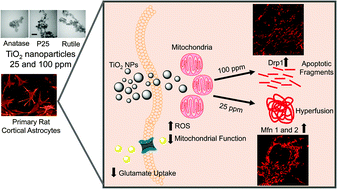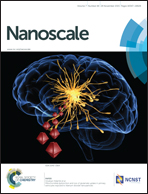Mitochondrial dysfunction and loss of glutamate uptake in primary astrocytes exposed to titanium dioxide nanoparticles†
Abstract
Titanium dioxide (TiO2) nanoparticles are currently the second most produced engineered nanomaterial in the world with vast usage in consumer products leading to recurrent human exposure. Animal studies indicate significant nanoparticle accumulation in the brain while cellular toxicity studies demonstrate negative effects on neuronal cell viability and function. However, the toxicological effects of nanoparticles on astrocytes, the most abundant cells in the brain, have not been extensively investigated. Therefore, we determined the sub-toxic effect of three different TiO2 nanoparticles (rutile, anatase and commercially available P25 TiO2 nanoparticles) on primary rat cortical astrocytes. We evaluated some events related to astrocyte functions and mitochondrial dysregulation: (1) glutamate uptake; (2) redox signaling mechanisms by measuring ROS production; (3) the expression patterns of dynamin-related proteins (DRPs) and mitofusins 1 and 2, whose expression is central to mitochondrial dynamics; and (4) mitochondrial morphology by MitoTracker® Red CMXRos staining. Anatase, rutile and P25 were found to have LC50 values of 88.22 ± 10.56 ppm, 136.0 ± 31.73 ppm and 62.37 ± 9.06 ppm respectively indicating nanoparticle specific toxicity. All three TiO2 nanoparticles induced a significant loss in glutamate uptake indicative of a loss in vital astrocyte function. TiO2 nanoparticles also induced an increase in reactive oxygen species generation, and a decrease in mitochondrial membrane potential, suggesting mitochondrial damage. TiO2 nanoparticle exposure altered expression patterns of DRPs at low concentrations (25 ppm) and apoptotic fission at high concentrations (100 ppm). TiO2 nanoparticle exposure also resulted in changes to mitochondrial morphology confirmed by mitochondrial staining. Collectively, our data provide compelling evidence that TiO2 nanoparticle exposure has potential implications in astrocyte-mediated neurological dysfunction.


 Please wait while we load your content...
Please wait while we load your content...